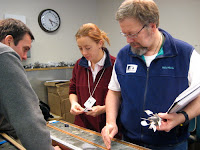Today was my third and final attempt to go on a helicopter field trip to the Dry Valleys. I have been so very excited to do this trip, led by Peter Webb, an Antarctic Old-Timer and a man who has been pivotal in Antarctic geology. Unfortunately, as I write, we are on hold due to snowy weather, and it is not looking very promising.
Because I expected to be out in the field today, my bags are completely packed. I rather relish this state of unexpected calm as I wait to hear on the status of helicopters. There is much to reflect on and I have had precious little time to be alone with my thoughts. In my office here in the Crary Lab, fingers are pounding away on keyboards as people are posting last-minute blogs, or uploading photographs to shared drives. I find myself glued to the window, looking at the snow and remembering the horizons that surround McMurdo. I can’t see them now, but last night at midnight I took a walk to look across McMurdo Sound at the volcanic peaks protruding through ice. The ice was brightly reflecting the intense midnight sun. This truly is a magical place. And a threatening place. From the heart of Mt. Erebus where a lava lake is bubbling and gasping, to the South Pole where the temperature has not risen above -27 degrees F since I have been here. From the highest peak, the Vinson Massif towering at 16,067 feet, to the expansive and ephemeral frozen sea on which we daringly land airplanes.
 From pressure ridges that reveal the colliding powers of the tides, sea ice, and incoming glaciers,
From pressure ridges that reveal the colliding powers of the tides, sea ice, and incoming glaciers,  to the maternal watchings of the Weddell Seals over their newborn pups. From the historical journey into Scott’s hut where I touched the very table where meals and conversations were shared, to the launching of a weather balloon to go 80,000 feet into the atmosphere, with a message to my school and my family written on the side – and rushing into the lab to see how it is transmitting data back. And from the excitement of seeing the first ANDRILL cores arrive in the lab full of layers of recent volcanic rocks,
to the maternal watchings of the Weddell Seals over their newborn pups. From the historical journey into Scott’s hut where I touched the very table where meals and conversations were shared, to the launching of a weather balloon to go 80,000 feet into the atmosphere, with a message to my school and my family written on the side – and rushing into the lab to see how it is transmitting data back. And from the excitement of seeing the first ANDRILL cores arrive in the lab full of layers of recent volcanic rocks,
to the joy of hearing my students’ excited voices when I called from Antarctica to share my experiences. These are images I will not soon forget.
If my photographs were somehow lost tomorrow, I would be greatly saddened – mostly because I would not be able to share them with all of you. But having seen these sights, and experienced these images, they will forever be a part of me, captured in my mind’s eye. One changes after experiencing the elements and sights here. I think you are never quite the same person when you go home, than when you arrive.
It has been quite a ride. I am constantly reminded of how very small and insignificant I am in the greater scheme of things. People will come and go, but Antarctica’s natural processes will carry on with little regard for our presence.
 Nature rules on this continent – and we are merely passing visitors. But those of us who have the privilege of being here are lucky, indeed. We are lucky not just to experience what Antarctica has to offer us, but also to be probing into the natural history and finding out about the secrets hidden within the ice and rocks, and, for some, the atmosphere and animals. It is a position of great responsibility to investigate these mysteries to share them with the world. I feel honored to be sharing this responsibility with the ANDRILL team.
Nature rules on this continent – and we are merely passing visitors. But those of us who have the privilege of being here are lucky, indeed. We are lucky not just to experience what Antarctica has to offer us, but also to be probing into the natural history and finding out about the secrets hidden within the ice and rocks, and, for some, the atmosphere and animals. It is a position of great responsibility to investigate these mysteries to share them with the world. I feel honored to be sharing this responsibility with the ANDRILL team.
Tomorrow at this time I will be in New Zealand. This will be my last dispatch from “the ice” – but certainly not my last blog. Thank you all for sharing the experience with me – and please continue to visit the www.andrill.org website as we share our findings and images, and continue our blogs.


No comments:
Post a Comment